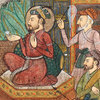A Thangka with Avalokiteshvara, Tibet, late 19th Century.
Depicting Avalokiteshvara in English known as the 'All Seeing Lord with One Thousand Hands and Eleven Faces', his six primary hands holding a mala, dharmachakra, bell, lotus, and long-life vase, wearing a dhoti with belt and ornaments, with various buddhas, Gelugpa lamas. Mesurement motif 63x87 cm. Full measurement hanging 83x126 cm.
Handling creases, holes, stains. Wear.
Provenance
The Bengt and Lilavati Häger Collection of Indian Collection of Indian, Southeast Asian, Chinese and Japanese Art.
.
Lilavati and Professor Bengt Häger’s art collection was culturally significant and vast. It is clear that it was founded on the couples cross cultural experiences. Lilavati was a leading exponent of Indian dance and Bengt one of the most important European Impresarios of his day.
Multitalented and highly regarded Bengt Häger (1916-2011) worked inexhaustibly throughout his life to promote dance as an independent art form and field of research. He founded and managed the Swedish Dance Museum, the University Collage of Dance and Circus in Stockholm. He worked actively to bring international guest performances from world leading dance companies. Organized international torus for Swedish dance companies such as the Cullberg Ballet, which he managed 1967-1987. He was the first to bring Peking Opera out of China after the revolution and was a great friend of the renowned Peking Opera singer Mai Lanfang.
For many years Mr Häger was the closest friend and collaborator of the famous Art Collector Rolf the Maré (1888-1964), founder of Ballet Suedois in Paris. Bengt was also involved with UNESCO and founded the Centre International de Dance.
Lilavati Devi (1925-2002). First came to Sweden as a principal performer of the dance company set up by Ram Gopal (1912-2003), the Nijinsky of India. Bengt and Lilavati married in 1954. She became an important ambassador of Indian Dance in Scandinavia. They couple came to inhabit a circle that included some of the major international dancers, performers and choreographers of the last Century.
More information
Avalokitesvara has a number of Body parts and objects with symbolic meaning. Of his 11 heads, the central head one at the top belongs to Amitabha. He often has multiple arms, sometimes more than a thousand of them. The central pair of hands is in the cupped position representing respect. In one hand he hold a Lotus, symbolizing Enlightenment, In another he holds a bow and arrow, symbolizing a Bodhisattva’s ability to get at the Heart of the matter.
Avalokitesvara appears in 33 different manifestations and 108 forms, including the Goddess of mercy, popular with pregnant mothers and invoked by people in trouble. Simply repeating her name several times is considered enough to drive away Evil.







































